The Internet of Things (IoT) is pivotal in connecting and empowering devices to enhance efficiency and convenience. AWS IoT services emerge as a cornerstone within this dynamic ecosystem, providing robust solutions for various applications. This review delves into Amazon IoT services' key features and applications, highlighting their significance in industrial IoT, home security, automation, and more.
Aloa, an expert in software outsourcing, is dedicated to assisting businesses and startups in navigating the challenges of integrating IoT solutions. With a focus on best practices and partner solutions, Aloa empowers clients to leverage Amazon IoT services effectively. From predictive quality to connected home solutions, Aloa ensures that businesses harness the full potential of Amazon IoT services.
This blog will explore the AWS IoT services, including their notable features, benefits, alternatives, and key takeaways. Afterward, you will understand how Amazon IoT services can revolutionize their approach to scalable industrial IoT applications, operational data management, and the next generation of connected devices.
Let's get started!
What Is AWS IoT Services
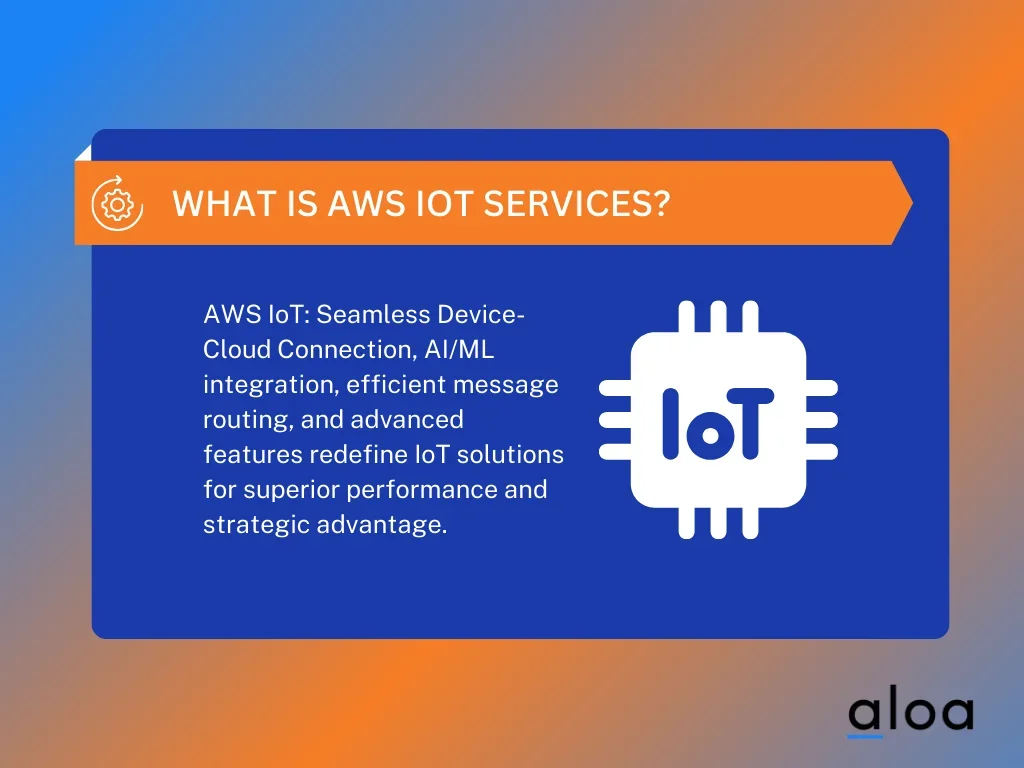
AWS IoT services, a cornerstone of cutting-edge technology, empower a seamless connection between IoT devices and the robust capabilities of the AWS cloud. At its core, Amazon IoT services facilitate the secure and efficient exchange of device data, leveraging artificial intelligence and machine learning prowess.
One key aspect that sets AWS IoT apart is its ability to route messages efficiently, employing the prowess of AWS lambda and ensuring low-latency interactions. This infrastructure includes features such as device shadow and device advisor, which are crucial for preemptive action against potential issues. In the realm of connectivity, Amazon IoT services offer private LoRaWAN network options, ensuring mutual authentication and reliable communication.
In essence, Amazon IoT services redefine the landscape of IoT solutions, providing a foundation for the next generation of devices, from consumer to commercial IoT applications, promising better performance, robust analytics, and a strategic edge in a rapidly evolving technological landscape.
Use Cases of AWS IoT Services
AWS IoT offers a comprehensive suite of services enabling diverse applications across various domains. Here's an overview:

Device Software
AWS provides software solutions to connect and manage devices at the edge:
- FreeRTOS: An operating system tailored for microcontrollers, simplifying the management of small, low-power edge devices.
- AWS IoT Greengrass: Facilitates building, deploying, and managing intelligent IoT applications at the edge using an open-source edge runtime and cloud service.
- Amazon Kinesis Video Streams: Securely processes and stores video and time-encoded data from connected devices at any scale.
- AWS IoT ExpressLink: Transforms any embedded device into an IoT-connected device with minimal design effort.
Connectivity and Control Services
These services ensure secure and efficient device management:
- AWS IoT Core: Connects IoT devices to AWS without provisioning or managing servers.
- AWS IoT Device Defender: Continuously audits IoT configurations to secure a fleet of IoT devices.
- AWS IoT Device Management: Facilitates easy registration, organization, monitoring, and remote management of IoT devices at scale.
- AWS IoT FleetWise: efficiently Collects, transforms, and transfers vehicle data to the cloud.
Industrial, Consumer, and Commercial Applications
AWS IoT enables various applications in different sectors:
- Industrial Operations: Develop industrial IoT applications for remote monitoring, quality improvement, and reducing downtime.
- Consumer Products: Creates connected applications for home automation, security, monitoring, and networking.
- Smart Buildings and Cities: Constructs commercial IoT applications addressing infrastructure, health, and environmental challenges.
- Mobility: Offers IoT applications that process and analyze connected vehicle data without managing infrastructure.
Featured Solutions
AWS IoT provides specialized solutions for specific needs:
- IoT Device Simulator: Simulates hundreds of virtual connected devices without configuring physical devices.
- Machine to Cloud Connectivity Framework: Connects on-premises operational technology assets to AWS Cloud for robust data ingestion.
- Vehicle Communication: Implements scalable and resilient communication architectures for next-generation vehicles.
- Agricultural Sensor Network: Builds applications to capture operational data and generate data-driven recommendations.
Notable Features of AWS IoT Services
AWS IoT Services stands as a robust and versatile platform designed to empower businesses to unlock the potential of IoT data and fuel growth. It's tailored to cater to various industrial, consumer, commercial, and automotive applications. Here's a breakdown of its notable features:
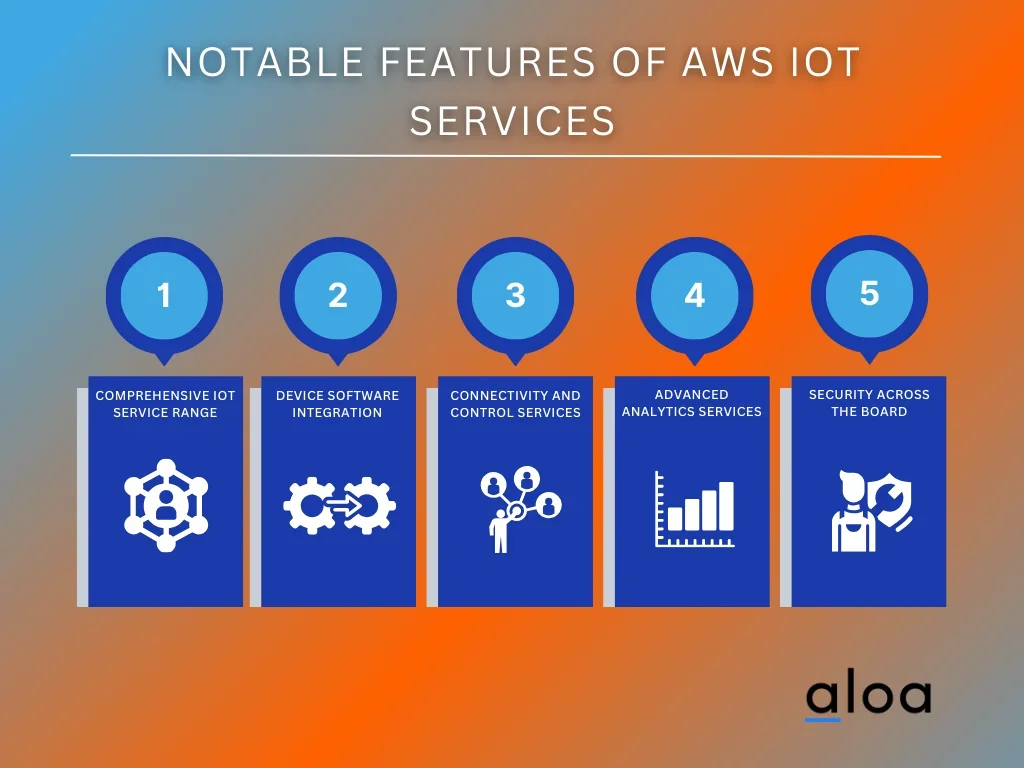
Comprehensive IoT Service Range
AWS IoT offers extensive device connectivity, management, storage, and analytics services. This array of services is essential for constructing complete IoT solutions, enabling businesses to scale quickly, innovate, and save costs.
Device Software Integration
At the heart of AWS IoT are potent device software capabilities. For instance, FreeRTOS provides an operating system for microcontrollers, simplifying the management of small, low-power edge devices. AWS IoT Greengrass allows the building, deploying, and managing of intelligent IoT applications directly at the edge. Furthermore, Amazon Kinesis Video Streams efficiently processes and stores video and time-encoded data from connected devices at any scale.
Connectivity and Control Services
AWS IoT excels in device management and security. AWS IoT Core facilitates the connection of IoT devices to AWS without server provisioning or management. AWS IoT Device Defender continuously audits IoT configurations to secure IoT devices. Additionally, AWS IoT Device Management streamlines the registration, organization, monitoring, and remote management of IoT devices at scale.
Advanced Analytics Services
The platform offers sophisticated analytics services to swiftly derive value from IoT data. AWS IoT SiteWise collects and analyzes industrial data, enabling data-driven decision-making. AWS IoT Events allows for the easy detection and response to events from various IoT sensors and applications. AWS IoT Analytics simplifies running analytics on large volumes of IoT data, and AWS IoT TwinMaker aids in creating digital twins of real-world systems to optimize operations.
Security Across the Board
AWS IoT ensures comprehensive security for IoT applications, from cloud to edge. It incorporates preventive mechanisms such as encryption and access control, alongside consistent auditing and monitoring with AWS IoT Device Defender to protect device data.
AWS IoT Services Pricing Plan
AWS IoT Core offers flexible pricing tailored to your usage with no minimum fees. You're billed for connectivity, messaging, Device Shadow usage (device state storage), registry usage (device metadata storage), and rules engine usage (message transformation and routing). This structure ensures cost-effectiveness and transparency.
- AWS Free Tier with AWS IoT Core: AWS provides a Free Tier for 12 months from account creation, including 2,250,000 minutes of connection, 500,000 messages, 225,000 Registry or Device Shadow operations, and 250,000 rules triggered and actions applied.
- Connectivity: Connectivity is metered per minute and priced annually, with no extra cost for keep-alive messages.
- Messaging: Messaging costs are based on the number and size of messages. Messages up to 128 KB are supported, with costs calculated in 5 KB increments.
- Device Shadow and Registry: Usage is metered based on operations that access or modify Device Shadow or registry data, with pricing per KB increment.
- Rules Engine: The Rules Engine is billed per rule initiation and action applied, metered in 5 KB message size increments. Additional charges apply for data transfer outside the AWS region.
Pros and Cons of AWS IoT Services
Amazon Web Services (AWS) IoT services offer a comprehensive suite of solutions designed to facilitate the development and deployment of IoT applications. This examination delves into the pros and cons of AWS IoT services, providing insights into their strengths and weaknesses for businesses and developers.
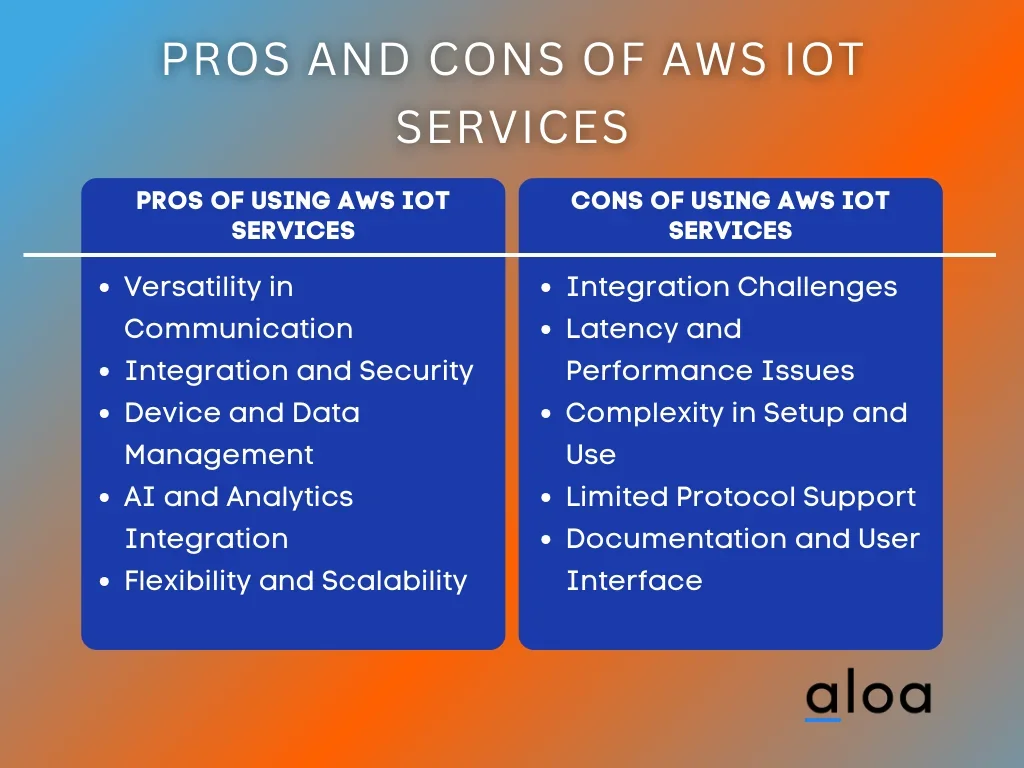
Pros of Using AWS IoT Services
AWS IoT Services offers a range of benefits according to user reviews from TrustRadius:
- Versatility in Communication: It effectively supports real-time data collection and communication, utilizing multiple protocols.
- Integration and Security: The service provides secure device connections with end-to-end encryption and the ability to integrate with various software solutions.
- Device and Data Management: AWS IoT excels in managing telemetric sensor communication and offers features like a rules engine for filtering and processing data.
- AI and Analytics Integration: It integrates well with AWS's AI solutions and supports powerful analytics for sensor data processing.
- Flexibility and Scalability: The platform is noted for its flexibility in choosing communication protocols and scalability.
Cons of Using AWS IoT Services
However, there are some drawbacks:
- Integration Challenges: Users noted a lack of integration with non-AWS IoT tools and desired broader compatibility.
- Latency and Performance Issues: Several reviews mention issues with latency, especially as systems scale and occasional performance lags.
- Complexity in Setup and Use: Integrating specific devices and designing business logic can be complex and daunting for beginners.
- Limited Protocol Support: There is a need to support a more comprehensive range of protocols and improve integration with various IoT products.
- Documentation and User Interface: Some users find the documentation lacking essential information and the interface somewhat challenging to navigate, especially for new users.
When to Use AWS IoT Services
As the world becomes increasingly interconnected with the proliferation of smart devices, understanding when to leverage AWS IoT services is crucial for businesses and developers looking to tap into the potential of IoT technologies.
Below, we explore five critical scenarios where Amazon IoT services can be particularly beneficial.
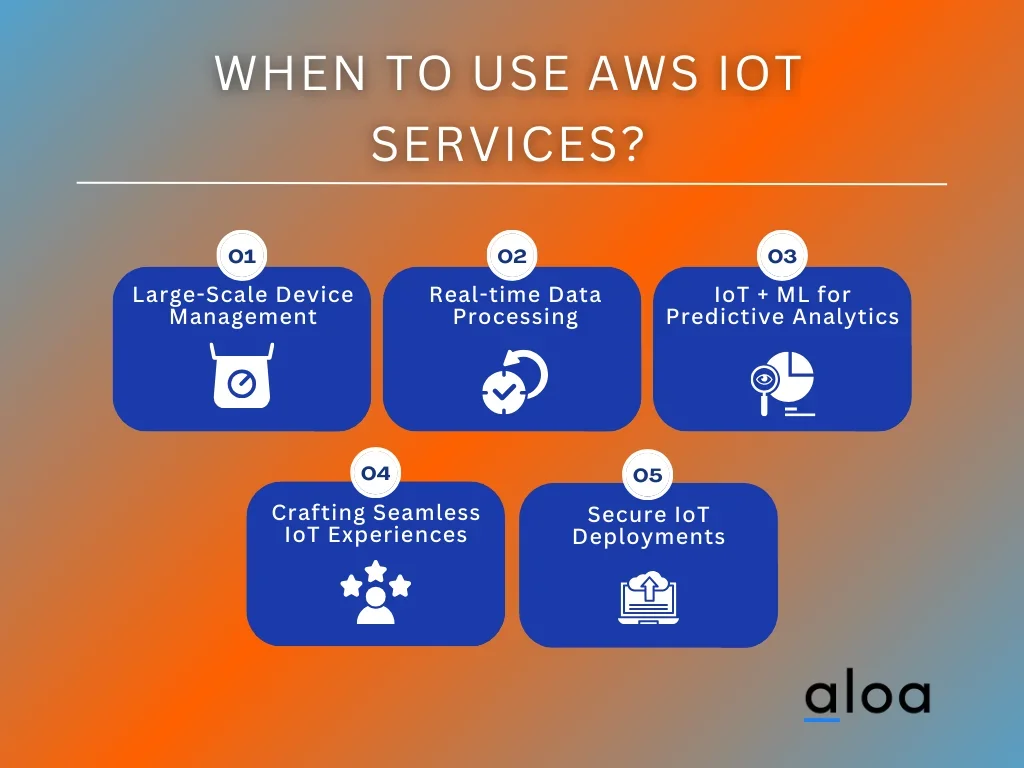
Large-Scale Device Management
When managing many IoT devices, AWS IoT services provide invaluable tools. AWS IoT Device Management, for instance, simplifies the task of securely registering, organizing, monitoring, and remotely managing IoT devices at scale. This is particularly useful for enterprises that deploy thousands of sensors and devices across multiple locations. With features like bulk registration, device shadowing, and secure communication, it streamlines operations and ensures seamless device performance.
Real-Time Data Processing and Analysis
Amazon IoT services excel in scenarios requiring real-time data processing from IoT devices. AWS IoT Analytics and AWS IoT Events enable collecting, processing, and analysis of large data streams in real-time. These services are invaluable for industries like manufacturing or logistics, where immediate data insights can lead to improved operational efficiency and decision-making. They provide the ability to filter, transform, and enrich IoT data before storing it, making it more actionable and accessible.
Integrating IoT with Machine Learning for Predictive Analytics
AWS IoT services integrate seamlessly with AWS's machine learning offerings, such as Amazon SageMaker. This integration is ideal for predictive analytics applications. For example, in predictive maintenance of industrial equipment, AWS IoT can collect sensor data, which is then analyzed using machine learning models to predict equipment failures before they occur. This not only reduces downtime but also saves costs associated with unplanned maintenance.
Creating Seamless IoT User Experiences
For businesses focusing on consumer IoT products, such as smart home devices, creating a seamless user experience is vital. Amazon IoT services offer the backend infrastructure and capabilities to support such experiences. AWS IoT Core, for instance, allows devices to interact quickly and securely with cloud applications and other devices. This connectivity is essential for creating intuitive and responsive user interfaces for smart home applications, wearables, and other consumer IoT devices.
Secure and Compliant IoT Deployments
Security and compliance are paramount in IoT deployments, especially in industries with stringent regulatory requirements like healthcare or finance. AWS IoT services provide robust security features that enable secure device connections and data transfers. AWS IoT Device Defender continuously audits configurations to align with security best practices. This ensures IoT deployments comply with industry standards and regulations, protecting sensitive data and maintaining customer trust.
AWS IoT Services Alternatives
AWS IoT provides services for building and managing IoT (Internet of Things) applications and devices. However, alternative IoT platforms and services are available from other cloud providers and independent companies. Here are some AWS IoT alternatives:
1. Particle - Best for Customizable, Full-Stack IoT Solutions
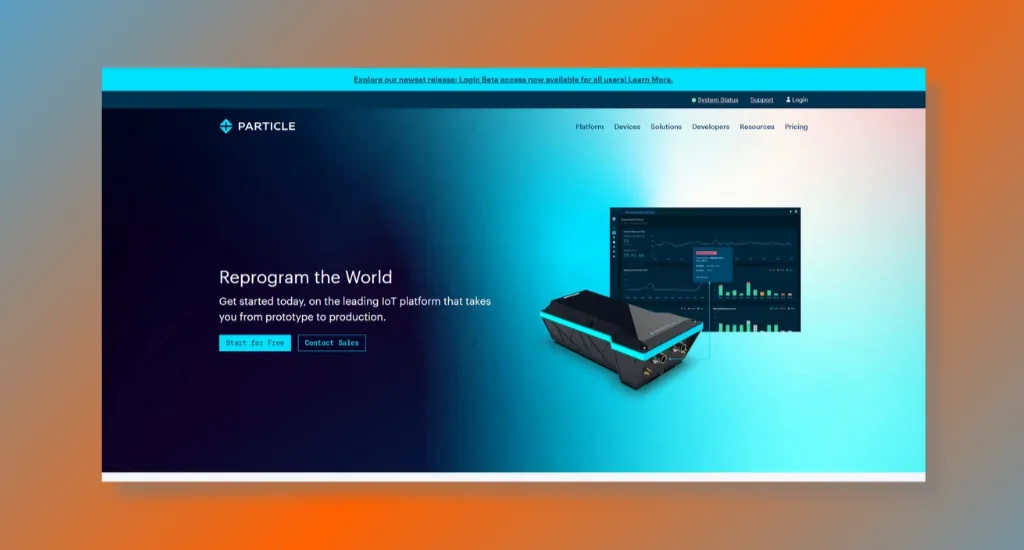
Particle offers a full-stack Platform-as-a-Service (PaaS) that simplifies the development of connected products. This integrated IoT solution seamlessly combines software, connectivity, and hardware. Particle stands out for its customizable approach, allowing the development of custom applications tailored to specific use cases.
Particle uniquely caters to a broad spectrum of industries, acting as a catalyst for companies seeking to enhance growth opportunities, customer experiences, and competitive advantages. Over 8,000 companies have utilized Particle to bring their connected products to market, highlighting its widespread acceptance and versatility.
Notable Features of Using with Particle
- Integrated Platform-as-a-Service: Offers a seamless combination of IoT software, connectivity, and hardware.
- Customizability: Enables the development of bespoke applications.
- Wide Industry Application: Suitable for various industries, including smart energy and HVAC.
- Easy Start-Up: Simplified process for companies to start with IoT solutions.
- Security and Scalability: Ensures the security and scalability of IoT solutions.
Particle Pricing Plans
While specific pricing plans are not detailed on their website, Particle offers a straightforward approach to getting started with their IoT solutions, catering to various business sizes and requirements.
Particle is ideal for businesses across various industries, especially those seeking customizable IoT solutions. Companies aiming to innovate in smart energy, HVAC, and industrial equipment monitoring would find Particle's services particularly beneficial.
2. Blynk IoT Platform - Best for Rapid IoT Development and Deployment

Blynk is a low-code IoT software platform that offers a unified solution for businesses and developers looking to build and maintain smart products. It provides a complete suite of tools including secure cloud services, firmware libraries, and intuitive app builders, all accessible from a central console.
Blynk stands out for its ability to cater to various industries, from smart home manufacturers to complex HVAC systems and agricultural equipment. It provides a no-code environment for building branded apps and gives users complete back-end IoT infrastructure with a single subscription. This accessibility and versatility make Blynk unique in the IoT platform market.
Notable Features of Using with Blynk
- Drag-n-Drop Editors: Enables the building of iOS and Android applications without coding.
- No-Code Web App: A robust dashboard with a drag-and-drop UI editor for device and user management.
- Simple APIs: Provides flexible firmware and REST APIs for seamless data exchange between hardware and applications.
- Hardware Compatibility: Supports over 400 hardware models, including ESP32, Arduino, Raspberry Pi, etc.
- Cloud Services: Includes a secure, ready-to-use cloud for immediate device connectivity.
Blynk Pricing Plans
- Free Plan: Suitable for exploration, offering support for two devices, five users, three templates, and basic historical data storage.
- Maker Plan: Starting at $6.99/month, ideal for personal projects with support for up to 20 devices/users and enhanced data and widget options.
- Pro Plan: Beginning at $99/month, designed for commercial prototyping with extensive device/user support, advanced widgets, and organizational management features.
- Enterprise Plan: A custom, white-label IoT solution offering branded apps, a private business server, and enterprise-level security and integrations.
Blynk benefits businesses and developers looking to prototype and deploy IoT solutions without extensive coding expertise. Its scalability suits users, from individual entrepreneurs and small startups to large enterprises seeking a comprehensive, customizable IoT platform. Its no-code app-building environment and extensive hardware support are advantageous for companies developing smart, connected products with minimal technical overhead.
3. Sentry - Best for Application Performance Monitoring and Error Tracking
Sentry specializes in application performance monitoring and error tracking, offering tools that enable developers to quickly identify, debug, and resolve issues. This platform stands out for its ability to prioritize critical issues based on their impact on customers. It provides detailed insights, including the environment, device, OS, and even the specific commit that introduced an error, all the way down to the broken line of code.
By automatically detecting critical performance issues, Sentry enables tracing of every slow transaction to underperforming API calls or database queries. Additionally, it offers browser profiling and testing in production environments, enabling optimization of resource consumption and faster troubleshooting.
Notable Features of Using with Sentry
- Error Monitoring: Rapid identification and resolution of errors, with detailed context and root cause analysis.
- Performance Monitoring: Detection of performance issues and visualization of slow transactions and operations.
- Automated Alerts: Customizable alerts and integration with various project management and development tools.
- Browser Profiling and Production Testing: Enables testing and optimization of app performance in real-world environments.
- Comprehensive Insights: Detailed insights into errors and performance issues backed by a robust analytics platform.
Sentry Pricing Plans
Sentry offers various pricing plans:
- Developer Plan: Free, providing limited error and performance monitoring with support for all languages, release tracking, and GitHub issues integration.
- Team Plan: Priced at $26/month (billed annually), offering core error and performance monitoring with unlimited members, third-party integrations, and metric alerts.
- Business Plan: Available for $80/month (billed annually), featuring standardized monitoring with advanced analytics, cross-project visibility, team-level roles, SAML support, and custom dashboards.
- Enterprise Plan: Full platform monitoring with cross-project insights and options for premium customer success, including data locality options, priority support, SLAs, single tenant options, and enhanced security and compliance.
Businesses of all sizes, particularly those reliant on digital applications and services, would benefit significantly from Sentry's offerings. This includes startups, medium-sized businesses, and large enterprises that require robust application performance monitoring and error-tracking capabilities. Sentry's solutions are particularly beneficial for development teams looking to optimize application performance, ensure reliability, and maintain high-quality user experiences.
Key Takeaway
AWS IoT services have emerged as a powerful force in the Internet of Things, offering a comprehensive suite of tools and features to enable seamless connectivity and data management for IoT devices. As explored in this review, AWS IoT Core, Greengrass, and Device Management provide the foundation for building scalable and secure IoT solutions across various industries.
The applications of Amazon IoT services are vast and continue to grow, from optimizing manufacturing processes to enhancing healthcare systems and building smarter cities. Real-world implementations and success stories underscore the transformative impact of AWS IoT on businesses and communities.
As the IoT ecosystem continues to evolve, AWS IoT services remain at the forefront, driving innovation and connectivity. To explore Amazon IoT services' endless possibilities and stay updated on the latest developments in the IoT world, connect with us at [email protected].

